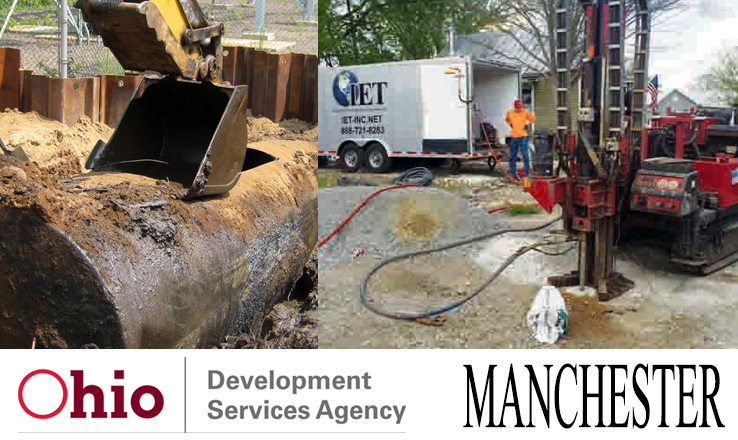
Hazardous eyesores will be restored, revitalized –
By Patricia Beech –
The clean up of abandoned gas station sites in Manchester continued last week as excavators dug up and removed disintegrating storage tanks that were leaking petroleum into the surrounding soil and ground water.
“Adams County is pleased to get started cleaning up several of our abandoned gas stations,” said Commissioner Ty Pell. “The effort put forth by our Economic and Community Development Department captured approximately $600,000 dollars for the Village of Manchester, and will continue to tap these resources for cleaning up Adams County.”
Funding for the project was awarded by the Ohio Development Services Agency. Projects are evaluated on the impact cleanup will have on the environment, the community, and the local economy.
“We’re funding local initiatives to transform blighted, high traffic corners into viable sites for development,” said David Goodman, director of the Ohio Development Services Agency. “We’re making what’s old, new again.”
The Darby family property located at 351 West Second Street was allotted a $100,000 grant, while the former Palmer’s Ashland Station at 501 East 2nd Street received $416,000.
The grants were administered through the Adams County Economic Development Office (ACEDO) which pursues innovative solutions for revitalizing local communities.
“We were on the ground and ready to go when this grant became available,” said Holly Johnson, Director of ACEDO. “The Board of Commissioners, the Economic and Community Development office, and Michael Weinstein with Patriot Engineering are partnering with the Village of Manchester to add tangible economic value and to help to revitalize their community.”
According to Weinstein, the clean up involves a two-stage process. First, chemicals are injected into the site to destroy the leaked petroleum, then a natural biological activity takes over and restores the earth to its natural state. The sites are then refilled with back fill and capped off with gravel. The emptied tanks are cut open and cleaned out before being hauled to a scrap metal yard.
While the tanks have been removed and the investigation completed at the former Ashland station, work is ongoing at the Darby location.
“At Darby we pulled the tanks, back filled the hole, and collected soil samples which we’ll send off to a certified lab to see what the level of contamination is,” said Weinstein. “We’ll come back after that and install ground water monitors to define the impact on the soil and water, and based on that we’ll make a decision about whether or not we need to excavate the soil and take it to a recycling facility to finish the cleanup.”




